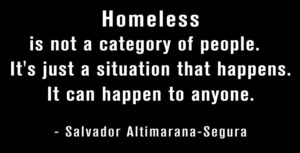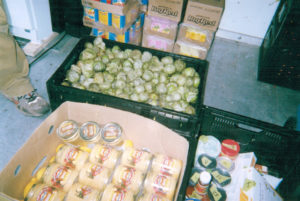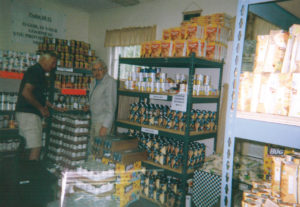January 5, 2021 at 8:53 pm

A food pantry is what it is because of three things:
the economic situation at the moment
the volunteers
the people who shop there.
The people come together looking for groceries but often, they want and need far more.
While the coronavirus pandemic rages, the food pantry lines get longer every pantry day because people, families, deal with change they didn’t ask for.
In short, they are rewriting their destiny stories without a road map or instructions.
A number of the people in the pantry, both shoppers and volunteers, didn’t know about food pantries until circumstances set up a situation where they suddenly looked around a room and realized where they were.
There is a name for their category – SITUATIONAL POOR.
A person fits into the situational poor category when s/he lands in a situation created by an event such as a hurricane, fire, floor, pandemic, or other disaster which destroys the home, car, job.
Pantries offer much – peace, community, spiritual connection, groceries. I always think of a food pantry in the basement of a church as a cross between a church service and a busy pizza place.
A food pantry, and those connected with it, are not a program. They are a community. As volunteers, all we really do is open the door. As all the hungry people walk through the door, they undergo a change somehow.
Each person in a pantry, in whatever capacity, has experienced rejection in some way – too young, too old, too crazy, too sick, too poor, not poor enough.
The food pantry experience does not heal a person, nor does it change the story.
The food pantry experience does not offer therapy.
The food pantry is, instead, a conduit for each person’s own healing.
FOOD PANTRY RULES
Sign your name in the register as you enter the pantry.
Find a place in line.
Do not crowd or block the door to the pantry room.
No more than 2 shoppers are allowed in the pantry at one time.
No more than one new shopper is allowed in the pantry at one time.
Shop for a three-day supply of food for everyone in your household.
Place your selections on the table as you shop.
Respect the restrictions on certain foods.
Finish your shopping in 10 minutes.
Once you begin to bag your groceries, do not continue to shop.
Because the food availability is different each time you shop, it is best to visit the food pantry weekly.
Thank you.
Thurman Greco
P.S. The rules may be different at the pantry where you shop. Each food pantry is different. The space is different. The times the pantry is open is different. The management is different.
These specific rules were used in the food pantry I managed where the people were many, the space small, and the hours few.
Please forward this article to your preferred social media network.
Share it with your friends.




April 14, 2020 at 11:09 pm

SITUATIONAL POOR – A person fits into a situational category of poverty when s/he lands in a situation created by an event such as a hurricane, fire, flood, pandemic, or other disaster which destroys the home, job, car.
Food pantries, food banks, soup kitchens are overworked in today’s pandemic world. The line of hungry people grows every time the place opens.
It’s bad enough that the line grows weekly. But, worse, many people in the line are confused, afraid. The never thought they would find themselves in a food pantry line with hundreds of other hungry, confused, afraid.
How should they act? What should they do?
What do they do with the food, once they get it home? It may be good food – both delicious and nutritious. However, it may not be anything recognizable. More often than not, pantry food doesn’t come with recipes. Super markets carry thousands of items. Food pantries carry maybe 50 different items and the labels on the cans and boxes aren’t even recognizable. The fresh produce may be organic but not be labeled as such.
So, now that the pantry food is in its new found kitchen, there is a big adjustment period involved in getting it to the table.
We are not so far removed from those people in the food pantry. They are our neighbors, friends, co-workers, relatives, classmates.
And, truth be told, we are all confused, and afraid.
Even though you may not be in the line, there are definitely things you can do. For starters, send a check to a food pantry, soup kitchen, or food bank in your area. If you don’t know where to send the check, look up an organization called:
Feeding America.
Feeding America is glue holding the food pantry world together. If that doesn’t work for you, search out: Regional Food Bank of Northeastern New York.
The Regional Food Bank of Northeastern New York, along with the Food Bank of the Hudson Valley, do an amazing job of making delicious, nutritious foods available to those who need it most.
These two food banks are only two in a large network of food banks located throughout the country. If you seeking a feeding facility in another part of the country, these organizations can guide you to one in the area best for you.
If you are uncomfortable sending money, this might be a good time to organize a food drive.
I wrote three action guides which list suggestions and options which are easy-to-understand and read. You can get these action guides free. Email me your mailing address and I’ll get your copies in the mail right away. I’m not even charging postage and handling.
Email me your mailing address to thurmangreco@gmail.com.
The guidelines and suggestions are practical. I feel confident you’ll discover practical things you can do to help on one of the action guides.
Thank you for caring.
Thanks for reading this article. Please refer it to your preferred social media network.
Thurman Greco
Woodstock, New York



June 4, 2014 at 7:30 am
“We are all angels for each other.” – Allan Gurganus
Not far from Kingston, New York lies a tiny community in the Catskill Forest named Olivebridge. This little community is tucked away on a side road off of a side road off Route 28. Blink and you’ll miss it. Well, Olivebridge has a pantry. I wish there were more Olivebridge pantries in our country.
Members of the Olivebridge Methodist Church built a small closet outside the entrance to their church building. They installed shelves. They put a sign on the door. Their darling little pantry is open 24/7/365. No signatures are required. No ID is necessary. Need food for a meal? Fine! Show up. Take what you need.
That’s all there is to it.
All pantries are different. Some are large – serving thousands of people monthly. Not all communities need a huge pantry. However, all communities can use small pantries like the one in Olivebridge. These small pocket pantries serving less than eighty people monthly offer a much needed service.
If congregations, schools, hospitals, fire houses, court houses, community centers, senior centers, daycare centers have a closet pantry, there won’t be so many congregations with pantries overwhelmed with lines of people outside their doors.
ATMOSPHERE quiet, rural
SERVICE self service
SOUND LEVEL During daylight hours, birds can be heard singing in neighborhood trees.
FOOD OFFERED On both occasions when I visited the pantry, there were canned beans, fruits, and vegetables. There was also a small assortment of pastas with jars of pasta sauce. Cereal, baby food, and pet food were also available. Non food items included shampoos and an envelope filled with grocery store coupons. Empty grocery bags were on the top shelf. There was no fresh produce available.
HOURS This pantry never closes.
USUAL WAIT TIME none
WHEELCHAIR ACCESS none
TO DONATE TO THIS PANTRY Send a check to Olivebridge United Methodist Church, Pastor Karin L. Squires, P. O. Box 1397, Olivebridge, New York, 12461. The phone number is 845-657-8494. The actual location of this pantry, if you want to bring a food donation, is 5179 Route 213, Olivebridge, New York.
PANTRY AFFILIATION To my knowledge, this pantry is a totally independent facility, operated by members of the Olivebridge United Methodist Church.
FINALLY The Olivebridge United Methodist Church cafe and thrift shop opens on Saturdays from 11 a.m. to 2 p.m. The last time I visited, the menu included hot dogs, orange jello squares filled with shredded carrots, and coffee.
Thank you for reading this blog/book.
Please share this article with your preferred social network.
Please send a comment.
Thurman Greco












